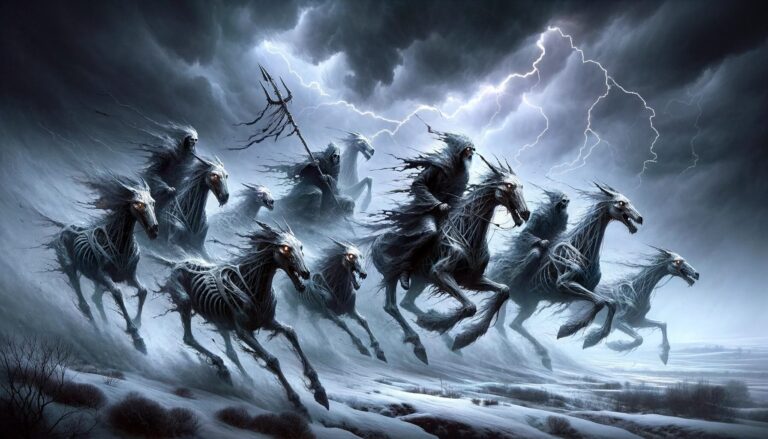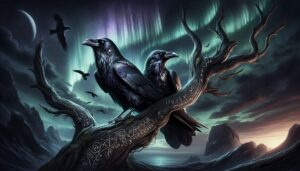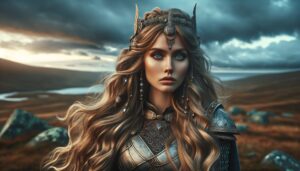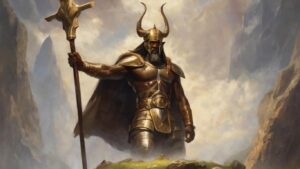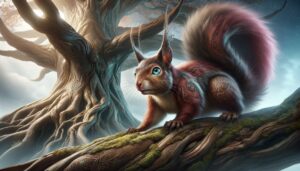Table of Contents
Origins of the Wild Hunt
The Wild Hunt, a phenomenon rooted in the heart of European folklore, is a spectral and enigmatic procession that traverses the night skies and haunted woodlands. This captivating mythic occurrence has weaved its way through centuries, leaving behind a trail of chilling stories, cultural interpretations, and symbolic depth. To embark on an exploration of the Wild Hunt is to embark on a journey through the depths of human imagination and the very essence of the mysterious.
The mythologies of Northern Europe deeply intertwine with the origins of the Wild Hunt. One of the most prominent and enduring renditions of the Wild Hunt traces back to the ancient Germanic tribes, who referred to it as the “Wilde Jagd” or “Wodan’s Hunt.” In Norse mythology, Wodan, also recognized as Odin, held the position of the chief deity in the Germanic pantheon. He assumed leadership over the spectral procession of the Hunt, with tales telling of the souls of the departed uniting with him on this ethereal journey.
Source
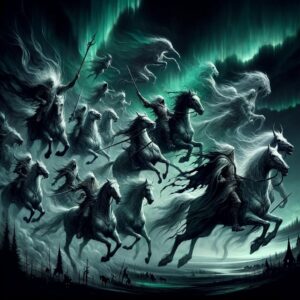
The Wild Hunt made its initial appearance in the Anglo-Saxon Chronicles in 1127 AD. Subsequently, in 1673, Johannes Scheffer, within his book “Lapponia,” shared stories from the Laplanders or Sami people regarding the Wild Hunt. Similarly, in 1895, author Hélène Adeline Guerber explored Odin and his steed, Sleipnir, in her work “Myths of the Northern Lands.” She vividly described the souls of the departed being swept away on the tumultuous winds of the hunt.
The concept gained further prominence when author and mythologist Jacob Grimm popularized it in 1835 through his work “Deutsche Mythologie.” In his interpretation, Grimm skillfully blended folklore with textual evidence spanning from the Medieval to the Early Modern period. Despite facing criticism for his methods, he emphasized the ever-evolving nature of folklore. He proposed that the myth had ancient, pre-Christian origins and put forward the idea that its enigmatic leader could have its roots in the legends of Odin, especially the darker aspects of his character. Furthermore, Grimm contemplated the possibility of the hunt’s leader being a woman, potentially a heathen goddess named Berchta or Holda. He even pondered whether this female figure could be Odin’s wife, adding a layer of mystique to the enduring myth.
The Mythic Spectacle
The Wild Hunt is a nocturnal phenomenon, a ghastly procession that materializes under the veil of darkness. It is said to occur during the winter months, particularly on stormy and moonless nights when the world is cloaked in shadow. The spectral hunters, often depicted as mounted on ghostly steeds and accompanied by baying hounds, tear through the night sky or race through the haunted woods. Their thunderous clamor and eerie cries strike terror into the hearts of all who hear it.
The spectral hunters themselves are a motley crew of supernatural beings. Among them are restless spirits of the dead, fallen warriors, and mythical creatures such as elves and faeries. They are led by a powerful and enigmatic figure, often associated with a deity or a legendary hero. In the case of the Germanic Wild Hunt, it is Odin who commands the hunt, riding his eight-legged steed, Sleipnir, and brandishing his mighty spear, Gungnir.
Symbols and Interpretations
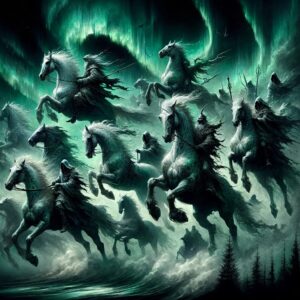
The Wild Hunt is a rich tapestry of symbols and interpretations, each layer adding depth to its mystique. One interpretation of the Hunt is that it represents the souls of the restless dead, condemned to roam the earth for eternity. In this sense, it serves as a cautionary tale, a reminder of the consequences of a life lived in excess or wickedness.
Alternatively, the Wild Hunt has also been seen as a harbinger of doom, a foreboding omen that precedes catastrophe or war. The tumultuous and destructive nature of the Hunt’s passage symbolizes the chaos and upheaval that may follow in its wake. It is a manifestation of the primal forces of nature, unbridled and untamed.
Culturally, people used the Wild Hunt to explain natural phenomena. In Scandinavian folklore, they believed that the howling wind during winter storms echoed the Hunt’s passage. This connection between the Hunt and the elements further solidifies its status as a symbol of nature’s uncontrollable power.
The Hunt in Myth and Story
The Wild Hunt has etched an enduring legacy upon the folklore and literature of Europe. In the British Isles, it goes by names such as the “Wild Ride” or the “Furious Host,” with tales of the Hunt proliferating. Within Welsh mythology, Gwyn ap Nudd, the ruler of the Otherworld, takes center stage as the leader of the spectral procession that traverses the nocturnal skies. Encounter with the Hunt could result in a journey to the Otherworld or dire consequences for those involved.
In Germanic folklore, people associate the Wild Hunt with the god Odin and often view it as a harbinger of death. They believed that those who witnessed the Hunt would either die or get transported to the spirit realm. The Hunt’s presence within these narratives instills a sense of dread and unease, mirroring the conviction in its supernatural and foreboding nature.
The Leader of the Hunt
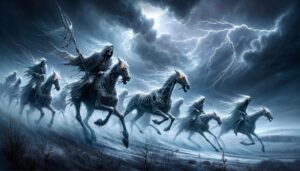
In various legends, different leaders helm the hunting party. In Germany, leaders bear names like Holt, Holle, Berta, Foste, or Heme. Yet, one figure frequently emerges: Odin, also known as Woden. Odin assumes two distinct names, Jólnir and Jauloherra, correlating with the timing of the alleged Wild Hunt – Master of Yule, celebrating seasonal change.
The legend evolves over time, shifting leaders based on geography and cultural shifts. In the Middle Ages, as heathen deities waned, heroes like Charlemagne, King Arthur, or Frederick Barbarossa took the helm.
The 16th century saw Hans von Hackelnberg leading the Wild Hunt. His tale includes slaying a boar, inadvertently poisoning himself, and opting to continue hunting in the afterlife. Wales attributes leadership to Gwynn ap Nudd, the Lord of the Dead, followed by blood-red-eared hounds. England features the ominous Gabriel hounds, harbingers of doom. Southern England points to Herne the Hunter, possibly linked to mythical king Herla. Orkney Island speaks of fairies or ghosts on white horses. Northern France tells of Mesnée d’Hellequin, the Goddess of Death, guiding the spectral procession.
The Cultural Impact
The enduring fascination with the Wild Hunt showcases its cultural impact. It inspires countless artists and writers in art, literature, and music. Paintings, sculptures, and poetry capture its haunting imagery.
In literature, authors like Sir Walter Scott and Washington Irving incorporate the eerie Hunt into captivating tales.
In music, the Wild Hunt is a subject for songs and compositions. Composer Carl Maria von Weber’s opera “Der Freischütz” features the Hunt prominently, adding a spectral dimension to the story. This auditory presence immerses listeners in its otherworldly aura.
Thematic Exploration
Beyond its role in storytelling and artistic expression, the Wild Hunt delves into profound themes that resonate with human experience. It embodies the duality of nature, the juxtaposition of beauty and terror that can be found in the natural world. The Hunt is both captivating and terrifying, a reflection of the awe and fear that nature can inspire.
Additionally, the Wild Hunt serves as a reminder of the impermanence of life and the consequences of one’s actions. In many myths, those who are pursued by the Hunt are often individuals who have led morally questionable lives. This moral aspect of the Hunt raises questions about redemption and the afterlife, challenging us to consider the consequences of our choices.
FAQ
Where does the Wild Hunt originate?
The Wild Hunt has its origins in European folklore, particularly among Germanic and Celtic tribes.
Who are the leaders of the Wild Hunt?
The leaders vary in different legends but can include figures like Odin, Gwyn ap Nudd, or even historical heroes like Charlemagne.
When does the Wild Hunt occur?
It is typically associated with the winter months, especially stormy and moonless nights.
What's the significance of the Wild Hunt?
The Hunt symbolizes various themes, including the supernatural, nature's power, and moral lessons about the consequences of one's actions.
How has the Wild Hunt influenced culture?
It has inspired art, literature, and music for centuries, with its eerie imagery and themes continuing to captivate creative minds.
Are there regional variations of the Wild Hunt?
Yes, different cultures and regions have their own interpretations and leaders of the Hunt, adding to its rich tapestry of folklore.
